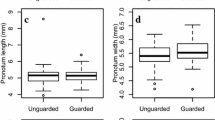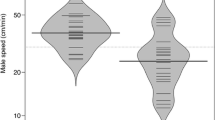Summary
-
1.
The postcopulatory behavior of the damselfly Calopteryx maculata (De Beauvois) (Odonata: Calopterygidae) was studied in field populations to determine the adaptive significance of guarding of ovipositing females by males. Of particular interest was an explanation for the guarding of ovipositing nonmates by males. A promiscuous mating system and the large variation in mating success (Table 1) among territorial males indicated that sexual selection may have been a significant factor in the evolution of C. maculata postcopulatory behavior.
-
2.
Territorial males defend ovipositing mates by chasing and displaying toward conspecific males attempting takeovers. Guarded mates averaged 12–15 min of undisturbed oviposition while unguarded females averaged only 1–2 min of oviposition prior to disturbance by males. Postcopulatory guarding is advantageous to both sexes because it allows undisturbed oviposition.
-
3.
During mating, 88%–100% of the sperm stored by a female from a previous mating was removed by a male before he transferred his own sperm to her storage organs. Given this potential for sperm displacement, postcopulatory guarding is advantageous to the guarding male since it assures him of fertilizing a substantial number of eggs prior to a subsequent mating by his mate.
-
4.
The duration of guarding (interval between matings) for males was 10–15 min. It did not differ significantly between two populations in on year. Guarding duration did not significantly change with (a) time of day, (b) time devoted to defensive behavior, (c) female arrival rate, and (d) presence of absence of an ovipositing female (Table 2).
-
5.
Males frequently guarded females with which they did not mate. Nonmates were guarded only when the male was simultaneously guarding a mate or had recently mated. These nonmates deposited eggs fertilized by rival males. Their presence did not significantly increase the time and energy expended by guarding males but did attract additional females (Table 3). However, these additional females did not lead to an increase in mating frequency for the guarding male.
-
6.
Three factors appeared to limit the ability of guarding males to exclude or attempt matings with arriving nonmates: (a) a lack of individual recognition, (b) a risk of losing a previous mate while failing to copulate with an arriving female, and (c) a probable physiologic limit to mating frequency. These limitations in male postcopulatory behavior were exploited by females.
-
7.
Some males were not territorial. While appearing less effective at obtaining mates, they devoted no time and energy to defending territories or mates. Because of sperm displacement, their reproductive success depended upon the ability of their mates to exploit the limitations in guarding behavior of territorial males.
Similar content being viewed by others
References
Alexander, R.D.: The evolution of social behavior. Annu. Rev. Ecol. Syst. 5, 325–383 (1974)
Bick, G.H.: A review of territorial and reproductive behavior in Zygoptera. Contact brief Nederlandse Libellenderzoekers No 10 [Suppl.], 1–14 (1972)
Boorman, E., Parker, G.A.: Sperm (ejaculate) competition in Drosophila melanogaster, and the reproductive value of females to males in relation to female age and mating status. Ecol. Entomol. 1, 145–155 (1976)
Corbet, P.S.: A biology of dragonflies. London: Witherby 1962
Darwin, C.: The descent of man and selection in relation to sex. London: John Murray 1871
Emlen, S.T., Oring, L.W.: Ecology, sexual selection and the evolution of mating systems. Science 197, 215–223 (1977)
Fisher, R.A.: The genetical theory of natural selection. New York: Dover 1958 (1929)
Hamilton, W.D.: Geometry for the selfish herd. J. Theor. Biol. 31, 295–311 (1971)
Heymer, A.: Eiablagverhalten der Libellen. Umsch. Wiss. Tech. 21, 665–666 (1968)
Heymer, A.: Verhaltensstudien an Prachtlibellen. Z. Tierpsychol. Beih. 11 (1973)
Jacobs, M.E.: Studies on territorialism and sexual selection in dragonflies. Ecology 36, 566–585 (1955)
Johnson, C.: Breeding behavior and oviposition in Calopteryx maculatum (Beauvois). Am. Midl. Nat. 68, 242–247 (1962)
Klötzli, A.M.: Zur Revierstetigkeit von Calopteryx virgo (L.) (Odonata). Mitt. Schweiz. Entomol. Ges. 43, 240–248 (1971)
Maynard Smith, J., Parker, G.A.: The logic of asymmetric contests. Anim. Behav. 24, 159–175 (1976)
Maynard Smith, J., Price, G.R.: The logic of animal conflicts. Nature 246, 15–18 (1973)
Pajunen, V.I.: Aggressive behavior and territoriality in a population of Calopteryx virgo L. (Odon., Calopterygidae). Ann. Zool. Fenn. 3, 201–214 (1966)
Parker, G.A.: Sperm competition and its evolutionary consequences in the insects. Biol. Rev. 45, 525–567 (1970)
Parker, G.A.: Courtship persistence and female-guarding as male time investment strategies. Behaviour 48, 157–184 (1974a)
Parker, G.A.: Assessment strategy and the evolution of animal conflicts. J. Theor. Biol. 47, 223–243 (1974b)
Parker, G.A.: Evolution of competitive mate searching. Annu. Rev. Entomol. 23, 173–196 (1978)
Sakagami, S.F., Ubukata, H., Iga, N., Toda, M.J.: Observations on the behavior of some Odonata in the Bonin Islands, with considerations on the evolution of reproductive behavior in Libellulidae. J. Fac. Sci. Hokkaido Univ. Ser. 6 19, 722–757 (1974)
Schmidt, E.: Zur Klassifikation des Eiablageverhaltens der Odonaten. Odonatologica 4, 177–184 (1975)
Trivers, R.L.: Parental investment and sexual selection. In: Sexual selection and the descent of man. Campbell, B.G. (ed.), pp. 136–179. Chicago: Aldine 1972
Waage, J.K.: Longevity and mobility of adult Calopteryx maculata (Beauvois, 1805) (Zygoptera: Calopterygidae). Odonatologica 1, 155–162 (1972)
Waage, J.K.: Reproductive behavior and its relation to territoriality in Calopteryx maculata (Beauvois) (Odon.: Calopterygidae). Behaviour 47, 240–256 (1973)
Waage, J.K.: Reproductive isolation and the potential for character displacement in the damelflies, Calopteryx maculata and C. aequabilis (Odon.: Calopterygidae). Syst. Zool. 24, 24–36 (1975)
Waage, J.K.: Oviposition duration and egg deposition rates in Calopteryx maculata (Beauvois) (Zygoptera: Calopterygidae). Odonatologica 7, 77–88 (1978)
Waage, J.K.: Dual function of the damselfly penis: Sperm removal and transfer. Science 203, 916–918 (1979)
Williams, G.C.: Adaptation and narural selection. Princeton: Princeton University 1966
Wilson, E.O.: Sociobiology: The new synthesis. Cambridge, Massachusetts: Harvard University 1975
Author information
Authors and Affiliations
Rights and permissions
About this article
Cite this article
Waage, J.K. Adaptive significance of postcopulatory guarding of mates and nonmates by male Calopteryx maculata (Odonata). Behav Ecol Sociobiol 6, 147–154 (1979). https://doi.org/10.1007/BF00292561
Received:
Accepted:
Issue Date:
DOI: https://doi.org/10.1007/BF00292561




